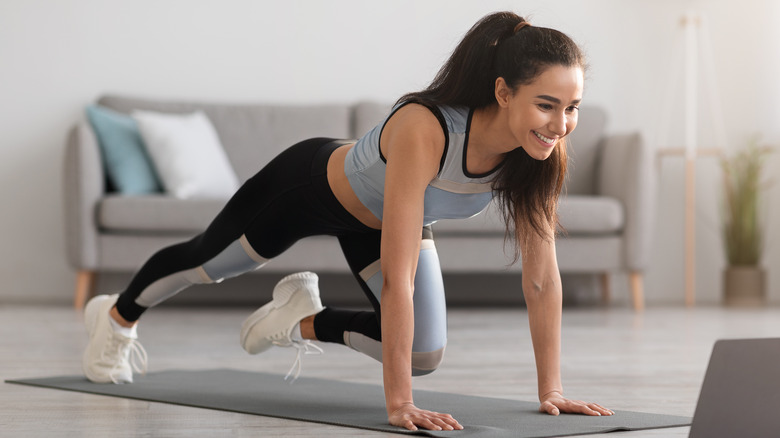Exercise of any kind can serve as a stress reliever. Due to the connection between adrenaline and cortisol and anxiety and stress, engaging in high-impact workouts or anything that increases heart rate can exacerbate the issue.
Pilates is low impact and, when done right, offers many advantages. You develop self-control over your body, breath, and thoughts. It is designed to improve posture, increase flexibility, strengthen muscles, and heighten mental awareness. It is known to relieve anxiety and stress by releasing tension in the body with the help of breathing techniques, providing more oxygen to the brain, and causing a feeling of calmness.
How Pilates helps improve Mental Wellness.
- Mind-Body connection
Pilates is a method of bringing your mind and body into harmony, not just a way to exercise. Experience an immediate sense of serenity as you step upon the mat. Every action is planned, just as every breath is planned. The muscles wake up as you move through the exercises, and your joints open up. It’s necessary to pay attention to your body’s requirements and the present moment.
- Focus and Concentration
Pilates is more than simply exercise; it’s a means to link your body and mind. It’s not only about the physical motions you do when you step onto the mat; it’s also about the focus and concentration you bring to each action. You set aside any outside distractions or tensions as you start your practice and focus inward.
- Endorphins and Pilates High
Nothing compares to the euphoria you get after a Pilates workout, and endorphins are to blame. Endorphins are organic hormones that the body releases during physical activity and are in charge of giving you that happy feeling. Take advantage of this inherent high and improve your attitude and outlook in each session.
In addition to strengthening your muscles during a Pilates class on the mat, your body gets a natural endorphin surge.
- Stress and Anxiety
From mindfulness and meditation to exercise and counseling, various methods can assist in lower stress and anxiety. Because it encourages rest, mindfulness, and physical activity, Pilates is also a great way to manage stress and anxiety.
In a Pilates session, you can concentrate on breathing, let go of muscle tightness, and establish a connection with your body that lowers stress and anxiety.
Pilates Exercise for Stress and Anxiety Relief
Breathing Exercise
- Place your hands over your ribs while lying down.
- Put your head, shoulders, and hips on the ground while keeping your feet flat and knees bent.
- Take a three-count deep breath, rising and expanding your lungs. Exhale slowly for three counts into your lower abdominals, then pull them back into your spine.
- Repeat this four to six times, releasing your jaw and face between each exhalation.
Spine Rotation Exercise

- Knees bent, lie on the ground.
- Draw your abdominals towards your spine while forming a ‘T’ with your arms, moving your head and both legs to the right and the left.
- Take a few deep breaths and concentrate on supplying your ribcage, back, and lower abs with new oxygen.
- As you draw your knees into your chest to support your lower back, keep your abdominal muscles tight to your lower back and switch to the other side. Repeat this a couple of times.
- Spinal rotation is the key to releasing tension in the chest, abdomen, and organs.
Bridge

- Keep your knee bent and aligned with your hips and heels as you lay down.
- Make sure your torso, or box, is square (shoulder to shoulder, hip to hip), and relax your upper body, chest, and head.
- Take a deep breath, elevate your hips without rounding your back, and maintain a tight core. Hold for three seconds before you breathe.
- Exhale while articulating your spine one bone at a time, beginning at the back of your neck. Your bottom is the last part of your body to contact the ground.
- The hips, back, and chest will open up, concentrating on the breath and the spine’s articulation, calming the nervous system and alleviating accumulated stress.
Relaxing techniques
- Fighting stress and despair with this calm Pilates session that targets the entire body may be successful.
- Feel less stressed and anxious by concentrating on your breath and your movements. This helps you become more present and focused.
- Letting go of muscle and joint tension with gentle movements and stretches can help with physical signs of stress.
Hip-opening exercise
- Since hip-opening exercises can be challenging, warm up your muscles and joints before beginning them with gentle stretches.
- In Pilates, your core serves as your foundation, and it is essential to hip-opening activities. To support your hips during each movement, contract your core muscles.
- Focus on taking deep breaths into your belly and big exhale as you perform hip-opening activities to help relieve tension.
- Keep your hips, knees, and feet in alignment during each movement.
- As you get more comfortable, gradually up the intensity after beginning with easy motions.
In conclusion, stress and anxiety are prevalent now more than ever, and working out has proven to be one of the most helpful ways to relieve and manage these stressors. Pilates is not only for your body but also for your mental health and improves your stress and anxiety levels.
Grab your mat and move to a calmer and more centered you. Maintaining mental health is just as important as your physical health. Stay tuned with us for more such blogs on health and fitness and check out our youtube channel https://www.youtube.com/hashtag/sweatpilates for our dynamic workout videos and nutrition recipes.
